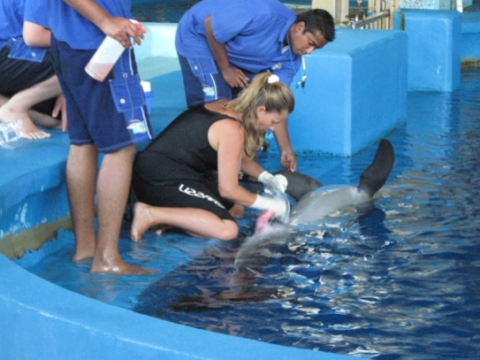There are lots of sperm competition among wildlife species. Is there sperm competition in humans?…….and is human sperm so bad after all?
Parker (1970) can be considered the modern father of sperm competition, as he defined this method of sexual selection as the competition between sperm of two or more males to fertilize the oocytes of a single female.This is very common in the animal kingdom, and almost the rule. In all animals from insects other invertebrates to vertebrates (fish, amphibians, reptiles, birds and mammals) there are abundant examples of sperm competition. This form of sexual selection is called polyandry and has many forms. In most instances semen/sperm quality is very high in these species. For example in bottlenose dolphins where as many as eight males compete for the same oocyte of one female, sperm motility is about 90% and normal sperm morphology is about 95%.

Fig1. Sperm collection from bottlenose dolphin – high sperm competition species – polyandry

Fig 2. Almost 100% normal dolphin sperm also indicative of high level of sperm competition
This is in contrast to the very strictly monogamous species such as the naked mole rat which has maximally 15% motile sperm and about 5 to10% morphologically normal sperm. A further surprising feature of the sperm of these naked rodent moles is that there seems to be a high level of sperm fragmentation in most sperm. The sperm in these moles show severe signs of degeneration and van der Horst (2014) indicated that this is a case of degenerative orthogenesis. Despite the fact that the sperm quality of these naked rodent moles can be considered extremely poor by any standards (See Fig. 3 below), they produce a large number of offspring after every mating.


Fig 3. 95% abnormal sperm forms not uncommon in the naked rodent mole – low level sperm competition.
Furthermore, there are similar examples of this among bird species and other animals thatappear to be strictly monogamous.
Humans are mainly monogamous despite the fact that they exhibit a wide range of sexual selection. In the context of monogamy they seem to exhibit similar features to animal species such as the naked rodent mole. Accordingly if sperm does not need a competitive advantage to fertilize the oocyte, will its qualitybe maintained or decline? The answer seems simple: In the absence of sperm competition sperm quality will not only decline but be very poor. The analogy of a very low percentage normal morphological sperm in humans compared to naked rodent moles do not seem to be a coincidence. It rather appears that in the absence of sperm competition, sperm quality declines but is still sufficient under these circumstances to fertilize the oocyte.
So, is human sperm quality in general that bad? The answer seems to be no. Poor sperm quality in general in humans appears to be a consequence of their evolutionary history of a lack of sperm competition. Why produce a Rolls Royce sperm like dolphins and rats (energy expensive) if you can produce poor sperm as in humans that are still capable of fertilizing the oocyte? It appears that human sperm in general is not so bad after all! May be Gynecologists and Embryologists can learn from this experience in terms of which mode of IVF they will chose for a specific patient.
Gerhard van der Horst (PhD, PhD)
Senior Consultant
MICROPTIC S.L.




Leave A Comment